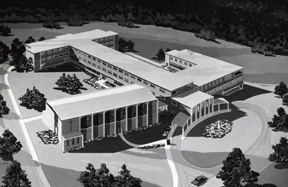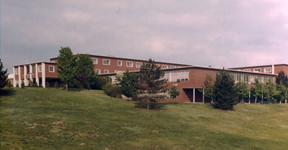IHM Novitiate Building, Scranton, Pennsylvania

Published by: RoseDog Books
The building for which Mother Kathleen is best remembered is the IHM Novitiate. (40) By October 1955, the council minutes reflect Mother Kathleen's plan to provide candidates and novices with enlarged space in a new building. The influx of some forty-five postulants yearly, and approximately eighty novices in the novitiate at a given time in the two-year cycle, resulted in extremely crowded conditions at the motherhouse.
In 1955, the purchase of part of the Apawana Golf Course as a future site for the new novitiate was discussed. This property was adjacent on the East to existing Congregation property and was situated on an elevated knoll above the other campus buildings. Two years later, on December 17, 1957, after the sale of St. Agnes Place, Elmhurst, the council minutes refer to the fact that the money from the sale of St. Agnes Place had been "invested in the Corn Exchange Bank of New York to purchase land from the Pennsylvania and Hudson Coal Companies for a new novitiate." (41)
Successful negotiating over the next six months ended with the acquisition of forty-eight acres of land by June 13, 1958. The total cost of the land was $48,286, which was paid for from savings. As with any large building project in the Scranton/Dunmore area, concern arose about underground conditions due to years of mining activity by the coal companies. Acting on information that a mine fire was burning underground somewhere in the vicinity, Mother Kathleen arranged for extensive studies to be done by professional engineers. Having determined that the area was protected by thick firewalls underground, the engineers pronounced the land safe for building. (42)
The plans and cost estimates of several architects were considered. In March 1959, Mother Kathleen and the council chose the architectural firm of Valverde and Franco. (43) It was estimated that the novitiate building would cost approximately $1,500,000. Initial expenses were met from the Building Fund, but from June 1961 through January 1962, $562,000 was borrowed from Northeastern Pennsylvania National Bank and Trust of Scranton. An additional $225,000 was borrowed in February and May 1962. (44)
To help meet the challenge of this financial burden, Mother Kathleen organized a group of men in 1958 that became known as the "Fathers and Friends of the Marywood Novitiate." At its height, there were three hundred members, most of whom were fathers of novices or postulants. These men were represented in twelve states and hundreds of cities, especially in New York and Pennsylvania. The presidents of the "Fathers and Friends" up to the time of the dedication of the building included Edward P. Rock, 1958–1959; Joseph A. Rooney, 1960; William G. Connolly, 1961; and Aloysius J. Wilson, 1962. The largest annual project of the association was the Marywood Autumn Fair, held over three days in October. The IHM Sisters and many friends donated handmade gifts and baked goods for the booths at the fair. The novitiate building dedication booklet comments:
Under the well-organized leadership of the Fathers and Friends, the Autumn Fair constitutes an inspiring and encouraging manifestation of the generous support of business and professional donors, as well as thousands of friends who patronize its activities. (45)
This organization continued until 1974, having sponsored the Marywood Autumn Fair for ten years, and subsequently conducting fund drives which featured Guy Lombardo Concerts, IHM Sisters Musicales, and dinners for the public, for a total contribution of $891,102. After each of the successful Autumn Fair events from 1958–1961, Mother Kathleen made known her deep appreciation of the work of the Fathers and Friends by letter and in her address at the yearly gratitude banquet. In 1958, for example, she wrote:
Your fine help in planning, and in executing these plans resulted in what was a really phenomenal affair. Full well we know that we of ourselves could never have achieved the success that your valuable help insured. We are most grateful to you and will ever hold in loving memory the record of your generous help . . . Again, permit me to thank you, as I pray that you who have done so much for our beloved Order will be abundantly blessed by God. May you and your dear ones reap God's abundant reward. (46)
Groundbreaking for the new building took place on May 30, 1960. The dedication booklet describes this event as "a triumphal day for the Fathers and Friends of the Marywood Novitiate." Undoubtedly, that could be said also for Mother Kathleen who, in spite of the pouring rain, "with undampered spirit . . . put her hand to the shovel turning the soil with comparative ease to the unsuppressed amusement of attending clergy and members of the community council, witnesses to the groundwork done by His Excellency." (47)

The architects, Valverde and Franco, must have spent many hours with Mother Kathleen as every detail of the 103,000 square foot contemporary, functional novitiate was developed. The spiritual focus of the novitiate was addressed, as a magnificent chapel became the dominating element of the "H" form plan. Features of the chapel included a custom-designed pipe organ and stained-glass windows portraying biblical events in the life of the Blessed Virgin Mary, as well as one window depicting Congregation history. With a seating capacity of four hundred, the chapel was designed to provide space for large groups attending receptions and professions of postulants, novices, and junior professed sisters.
Other dimensions of the life of a postulant and novice were given attention in well-lighted classrooms and a library; a well-equipped kitchen where the fine art of cooking for large groups would be learned; and spacious dining, dormitory, laundry, and recreational areas.
Mother Kathleen had been closely involved in the planning of the novitiate, including the communication of her desire that the dormitories be constructed in such a way that each novice and postulant would have a window in her sleeping area. And this was done. What did not occur according to her wish was the subject of several letters to and from Bishop Hannan regarding the use of oil instead of coal in heating the new building. Bishop Hannan, anticipating a negative reaction from area people if coal were not the fuel of choice, was quite emphatic in his refusal of support for the use of oil. Mother Kathleen set forth cogent reasons for the change, chief among which was the initial and future expense of using coal. She did, however, accede to the bishop's wishes after receiving the following statement from him:
Should you and your council decide on the use of oil instead of coal and should there be any censure of this action, I will not hesitate to disavow responsibility for the decision, even publicly, if the extent of the censure threatens to alienate a significant number of Catholics. (48)
After Mother Kathleen's letter of January 16, 1960, assuring Bishop Hannan of compliance with his wishes, the Bishop wrote: "This assures that neither I nor your Congregation will be confronted with the resentment of our Catholic working people." (49)
Mother Kathleen, as superior general of a congregation of some eleven-hundred sisters, having spiritual and temporal responsibilities of such great magnitude as her life story reveals, demonstrated the humility of greatness in a situation where her judgment could well have been upheld and supported. Interestingly enough, the heating system would have to be converted to natural gas and oil in subsequent years!
Mother Kathleen made many visits to the site of the new novitiate as it progressed. But she was not to see the completed fruit of her efforts. She was hospitalized in October 1961, and while she continued working from her hospital room until her death on January 31, 1962, she did not live to participate in the festive dedication on May 30, 1962 of her favorite project, the IHM Novitiate. On that occasion Mother Beata Wertz paid tribute to Mother Kathleen, saying:
. . . we rejoice in the dedication of this splendid building. It is a monument to our revered Mother M. Kathleen, who devoted herself wholeheartedly to its planning and construction. Every detail was of vital interest to her. Always in our memories, it will express to us the zeal with which she toiled in the care of our novices and postulants. (50)